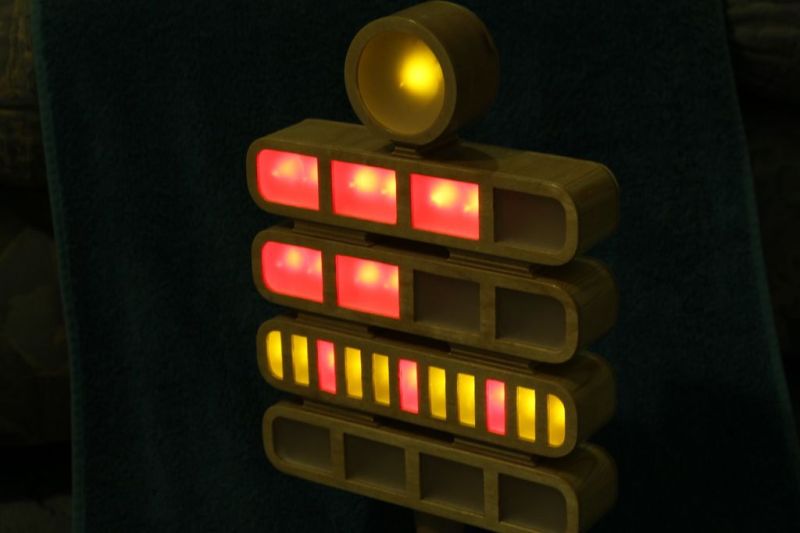Just when we thought we’d seen all the ways there are to tell time, along comes [mr_fid]’s Berlin clock build. It’s based on an actual clock commissioned by the Senate of Berlin in the mid-1970s and erected on the famous Kurfürstendamm avenue in 1975. Twenty years later it was decommissioned and moved to stand outside the historic Europa-center.
This clock tells the time using set theory and 24-hour time. From the top down: the blinking yellow circle of light at the top indicates the passing seconds; on for even seconds and off for odd. The two rows of red blocks are the hours—each block in the top row stands for five hours, and each block below that indicates a single hour. At 11:00, there will be two top blocks and one bottom block illuminated, for instance.
The bottom two rows show the minutes using the same system. Red segments indicate 15, 30, and 45 minutes past the hour, making it unnecessary to count more than a few of the 5-minute top segments. As with the hours, the bottom row indicates one minute per light.
Got that? Here’s a quiz. What time is it? Looking at the picture above, the top row has three segments lit. Five hours times three is 15:00, or 3:00PM. The next row adds two hours, so we’re at 5:00PM. All of the five-minute segments are lit, which adds 55 minutes. So the picture was taken at 5:55PM on some even-numbered second.
The original Berlin clock suffered from the short lives of incandescent bulbs. Depending on which bulb went out, the clock could be ‘off’ by as little as one minute or as much as five hours. [mr_fid] stayed true to the original in this beautiful build and used two lights for each hour segment. This replica uses LEDs driven by an Arduino Nano and a real-time clock. Since the RTC gives hours from 0-23 and minutes and seconds from 0-59, a couple of shift registers and some modulo calculations are necessary to convert to set theory time.
[mr_fid] built the enclosure out of plywood and white oak from designs made in QCAD. The rounded corners are made from oak, and the seconds ring is built from 3/8″ plywood strips bent around a spray can. A brief tour of the clock is waiting for you after the break. Time’s a-wastin’!
















A friend at the Madrid Makespace has also built one. Saying the logic is based on the set theory is a bit of an overstatement. Sure, the set theory is so basic that it is in pretty much everything, but this clock could be simply said to use two-digit numbers in base-5. Or you could simply explain it as a form of roman numbers or even simply EUR / USD coins of 5 and 1 cent kind of thing.
Would be an unique 24 hour clock for the radio shack. Can’t wait the time it would take to duplicate this? Download the app to your phone or tablet
The electronics and code can be done in an hour or two. The real work is the enclosure
Very nice, i’m tempted to make one myself.
QCAD, I have never used it, but from the screenshots it looks a bit dated, and it is 2D only.
I can highly recommend Free-CAD, which has been very stable since the last v0.15 release.
https://github.com/FreeCAD/FreeCAD
and of course OpenScad, which is just awesome.
I guess it’s art. Don’t recall ever noticing it.
I love QCAD.
To add some details: the bulbs died due to traffic causing vibrations that broke the filament. Solution was (but never was implemented due to death of inventor) to use double power incandescent lamps and drive them with half the load.
This trick was called the Ewigkeitsglühbirne and the brainchild of the Berlin-Uhr-Inventor. He thought it would be a great idea, because, well, the lamps lived way longer. Downside was that it used way more costs in energy than replacing the “faster” dying lamps.
And then came the LED…
Weren’t ” rough service” incandescent lamps available in Europe?
Might’ve been done for artistic considerations, whatever they are, but I think the minutes would’ve been better with all the red lights to the left, to make adding and counting them easier. Anyone got an email address for mid-1970s Germany?
Actually thinking about it, it’s a lot like the Roman numeral system, with different identifiers for different quantities. Also a bit like the weird bi-quinary system IBM used in an early computer mentioned here a little while ago.
Note: the clock does *not* actually use set theory. Please correct that. It does not make logical sense and is contradicted by the German Wikipedia: “Entgegen dem inoffiziellen Namen hat die Uhr nichts mit der Mengenlehre zu tun.” (Contrary to its inofficial name, the clock has nothing to do with set theory.) It seriously confused me for a few minutes, so it might be helpful to others, too, if you removed that claim from your article. Thanks!
Well, “Set Theory” is (loosely) the study of collections of objects. In this case, you have a row showing the collection of fives of hours, followed by the collection of ones of hours, followed by similar collections but for minutes instead. The Union of these collections, or sets, at any given time is – the time. (Gee I hope I got that right, I’m winging it…)
While living in Berlin, I stood in front of it and figured it out…there were no lights burned out so the time was correct..to me it was basic math based on a 24 hour time …I just loved it’s uniqueness..